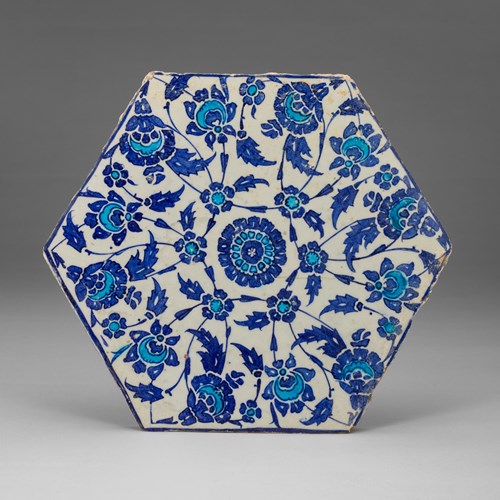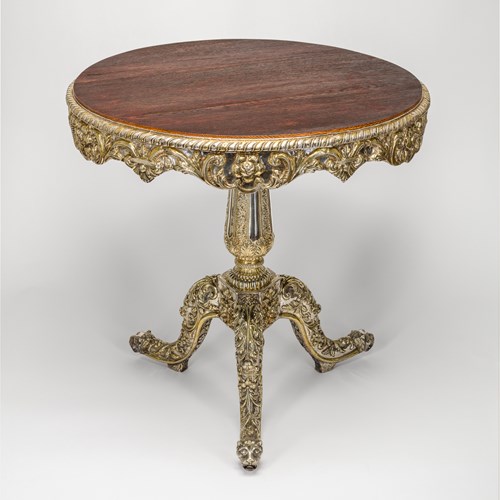Marketplace
ISLAMIC LUSTRE BOWL
This small bowl of biconical oval form dates to the late 12th or early 13th century, when it would have been used as everyday tableware by its middleclass Syrian owner.1 The interior decoration consists of a central roundel of intertwined flowers in chocolate-brown lustre, which is applied over the transparent turquoise glaze. Four panels radiate from here, divided by cobalt blue underglaze borders. Written in highly stylised floriated kufic, a pattern is created from the Arabic word al-‘izz, meaning glory, on a ground of tightly-packed spirals.2 An example of the al-‘izz pattern is seen on a ewer in the Metropolitan Museum of Art (accession no. 48.113.18). The exterior decoration consists of large spirals sandwiched between two thick brown lines, just below the rim. This was the most frequently occurring decoration on biconical bowls, dubbed the ‘spiral back’ by Robert B. Mason.3 Examples of other bowls bearing the spiral back pattern can be seen at the Ashmolean Museum in Oxford (accession no. EA1978.2175) and the Metropolitan Museum of Art in New York (accession nos 48.113.5, 48.113.6, and 48.113.8).
1 Beyazit, Deniz, in Canby, Sheila R., Beyazit, Deniz, Rugiadi, Martina, and Peacock, A. C. S. Court and Cosmos: The Great Age of the Seljuqs. New York: The Metropolitan Museum of Art/ Yale University Press, 2016. P. 119.
2 Jenkins-Madina, Marilyn. Raqqa Revisited: Ceramics of Ayyubid Syria. New York: The Metropolitan Museum of Art/ Yale University Press, 2006. P. 167.
3 See Mason, Robert B. ‘Medieval Syrian Lustre-Painted and Associated Wares: Typology in a Multidisciplinary Study.’ Levant 29 (1997). Pp. 169-200.
1 Beyazit, Deniz, in Canby, Sheila R., Beyazit, Deniz, Rugiadi, Martina, and Peacock, A. C. S. Court and Cosmos: The Great Age of the Seljuqs. New York: The Metropolitan Museum of Art/ Yale University Press, 2016. P. 119.
2 Jenkins-Madina, Marilyn. Raqqa Revisited: Ceramics of Ayyubid Syria. New York: The Metropolitan Museum of Art/ Yale University Press, 2006. P. 167.
3 See Mason, Robert B. ‘Medieval Syrian Lustre-Painted and Associated Wares: Typology in a Multidisciplinary Study.’ Levant 29 (1997). Pp. 169-200.
Date: Late 12th to early 13th century
Plus d'œuvres d'art de la Galerie




_T638491371114922044.jpg?width=500&height=500&mode=pad&scale=both&qlt=90&format=jpg)




